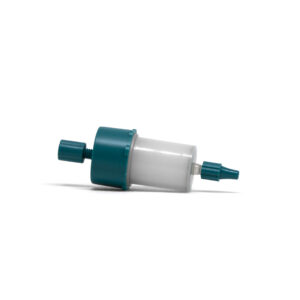Table 1. Resin Characteristics
| Bead Material
| Agarose |
| Bead Percentage
| 4% |
| Bead Size | 60-160 µm |
| Flow Rate1 | >20 mL/min (>680 cm/hr) @ 25oC |
| Binding Capacity (Hb)
| >35 mg of thyroglobulin/ml of resin |
| pH Stability2 | 3-12 |
| Storage Temperature | 2-8o C |
| Storage Buffer
| 10mM phosphate buffer, 150 mM NaCl, pH 7.5, containing 10 mM CaCl2, 10 mM MnCl2, 20 mM glucose and 0.05% sodium azide |
| Form | 50% Slurry
|
| Chemical Stability2 | Stable in all commonly used aqueous solutions and buffers. |
| Physical Stability2 | Negligible volume variation due to changes in pH or ionic strength. |
1Linear flow rate = volumetric flow rate (cm3/h)/column cross-sectional area (cm2)
2Data refer to the coupled product, provided that the ligand can withstand the pH or chemical environment. Please note the following: pH stability, long term refers to the pH interval where the medium is stable over a long period of time without adverse effects on its subsequent chromatographic performance. pH stability, short term refers to the pH interval for regeneration and cleaning procedures.
Instructions for Use
Concanavalin A (Con A) Superflow 4 is an affinity resin for the purification of glycoproteins, glycolipids and polysaccharides containing terminal α-D-mannopyranosyl, α-D-glucopyranosy sugars or sterically related residues. The resin is made by stably coupling purified Con A lectin to our highly crosslinked 4% agarose beads. Con A Superflow 4 resin doesn’t show leaching in commonly used buffers and is stable between pH range 4-12. Con A Superflow 4 should be stored in buffers containing CaCl2 and MnCl2, as these ions are required for its activity. Con A Superflow 4 can be used to purify IgM, exosomes, and other membrane vesicles. Sterogene Con A Superflow 4 resin is very robust. After usage, Con A Superflow 4 resin can be easily regenerated and utilized multiple times without significant loss in yield.
Concanavalin A or Con A is a tetrameric plant metalloprotein isolated from jack beans (Canavalia ensiformis). Con A is a mannose or glucose specific lectin and requires Ca++ and Mn++ for optimal activity. At neutral pH Con A retains tetrameric structure with one carbohydrate binding site at each protomer, at pH lower than 5.6 Con A dissociates in dimers, and above pH 7 it forms higher aggregates.
Con A Superflow 4 is supplied as 50% slurry in 10 mM phosphate buffer, 150 mM NaCl, pH 7.5 with 10 mM CaCl2, 10 mM MnCl2, 10 mM MgCl2 and 0.05% sodium azide.
Upon receiving, store the resin at 2-8oC. Do not freeze.
Warning:
Buffers with EDTA or pH lower than 4 should be avoided because both remove the ions from Con A, making it inactive.
Key features:
Matrix support: 4% crosslinked agarose beads
Immobilized ligand: Concanavalin A (Con A) lectin
Ligand density: 10 mg lectin/ml of agarose beads
Binding capacity: > 35 mg of thyroglobulin / ml of resin
Storage buffer: 10 mM phosphate buffer, 150 mM NaCl, pH 7.0 with 10 mM CaCl2, 10 mM MnCl2 and 0.05% sodium azide
Elution buffer: 0.1-0.3 M α-D-methylglucoside or α-D-methylmannoside (mixture of both can also be used)
Purification of Glycoprotein using Con A Supeflow4 resin:
Buffers required:
Equilibration Buffer: 10 mM phosphate buffer, 150 mM NaCl, pH 7.5 with 10 mM CaCl2, 10 mM MnCl2
Loading buffer: 10 mM phosphate buffer, 150 mM NaCl, pH 7.5
Wash Buffers: 10 mM phosphate buffer, 500 mM NaCl, pH 7.5
Elution buffer: 0.3 M α-D-methylglucoside or α-D-methylmannoside
Storage buffer: 10 mM phosphate buffer, 150 mM NaCl, pH 7.5 with 10 mM CaCl2, 10 mM MnCl2, 10 mM MgCl2 and 0.05% sodium azide.
Protocol:
Con A Superflow 4 resin can be packed in a disposable column (1-5 ml) or can be used in a spin column depending on the scale of purification.
Dilute the serum 1:1 in equilibration buffer, the cell culture supernatant can be added directly (without dilution) to the column. The loading samples should be spun at 15000 rpm at room temperature for 10 min to remove any precipitate, and only the clear supernatant should be applied to column. Care should be taken to remove any EDTA present in the loading samples.
Take out the resin from the fridge and equilibrate it at room temperature.
Pack the required amount of slurry to the column.
Equilibrate the packed column with 5 column volumes (CV) of equilibration buffer.
Wash the column with 5 CV of loading buffer.
Add the diluted serum or cell culture supernatant to the column at a slow flow rate.
Wash the column with 20 CV of wash buffer at high flow rate until no protein is detected in the flowthrough, based on OD at 280 nm.
Elute the bound glycoprotein with 0.1-0.3 M of elution buffer at slow flow rate and in multiple small fractions.
Take the OD at 280 nm to determine the concentrated fractions, run the SDS-PAGE and pool the fractions, dialyze in required buffer, concentrate, and store at required temperature.
Regeneration of Con A Superflow 4 resin:
Wash the used column with 3 CV of phosphate buffer (pH 8) containing 500 mM NaCl followed by 3 CV of sodium acetate buffer (pH 4.5) with 500 mM NaCl. Repeat this wash cycle 2-3 times.
Wash the column thoroughly with 10 CV loading buffer.
The Con A Superflow 4 resin can be stored in storage buffer (10 mM phosphate buffer, 150 mM NaCl, pH 7.5 with 10 mM CaCl2, 10 mM MnCl2, 10 mM MgCl2 and 0.05% sodium azide) at 4 °C.
To Download Instructions for use:
INST 937700SF4 ConA Superflow 4

